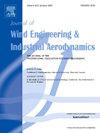Multifactor influence on critical velocity of an upward single-slope tunnel with a water spray system
IF 4.9
2区 工程技术
Q1 ENGINEERING, CIVIL
Journal of Wind Engineering and Industrial Aerodynamics
Pub Date : 2025-09-03
DOI:10.1016/j.jweia.2025.106223
引用次数: 0
Abstract
The smoke behavior of an upward single-slope tunnel fire under the water spray system is affected by longitudinal ventilation direction, the thermal buoyancy of high temperature smoke, stack effect generated by slope and drag force of water spray, which causes a change on critical velocity. Therefore, quantitative research on the effect of water spray system parameters on critical velocity is conducted in simulated sloped tunnels. Consequently, critical velocity decreases with elevated water spray flow rates and steeper tunnel slopes, which both amplify drag force and stack effect, thereby suppressing smoke back-layering, but it is little affected by water spray angle. Furthermore, there is still a segmentation function link between the dimensionless critical velocity and the dimensionless heat release rate (HRR), with an exponential relationship of 1/3 power. Influence elements with water spray flow rate and tunnel slope are introduced into critical velocity model. Comprehensive critical velocity prediction is established taking into account multifactor including tunnel slope, water spray flow rate and tunnel slope.
多因素对单坡上喷水隧道临界速度的影响
纵向通风方向、高温烟气的热浮力、坡度产生的烟囱效应、水雾阻力等因素影响了单坡上向隧道火灾的烟气行为,从而导致临界速度的变化。因此,在模拟边坡隧道中,定量研究了喷水系统参数对临界流速的影响。因此,随着喷水流量的增大和隧洞坡度的增大,临界流速降低,增大了阻力和烟囱效应,从而抑制了烟气反分层,但受喷水角度的影响不大。此外,无量纲临界速度与无量纲放热率(HRR)之间仍存在分割函数联系,呈1/3次幂指数关系。临界速度模型中引入了水雾流量和隧道坡度的影响因素。建立了综合考虑隧道坡度、水雾流量、隧道坡度等因素的综合临界流速预测模型。
本文章由计算机程序翻译,如有差异,请以英文原文为准。
求助全文
约1分钟内获得全文
求助全文
来源期刊
CiteScore
8.90
自引率
22.90%
发文量
306
审稿时长
4.4 months
期刊介绍:
The objective of the journal is to provide a means for the publication and interchange of information, on an international basis, on all those aspects of wind engineering that are included in the activities of the International Association for Wind Engineering http://www.iawe.org/. These are: social and economic impact of wind effects; wind characteristics and structure, local wind environments, wind loads and structural response, diffusion, pollutant dispersion and matter transport, wind effects on building heat loss and ventilation, wind effects on transport systems, aerodynamic aspects of wind energy generation, and codification of wind effects.
Papers on these subjects describing full-scale measurements, wind-tunnel simulation studies, computational or theoretical methods are published, as well as papers dealing with the development of techniques and apparatus for wind engineering experiments.

 求助内容:
求助内容: 应助结果提醒方式:
应助结果提醒方式:


